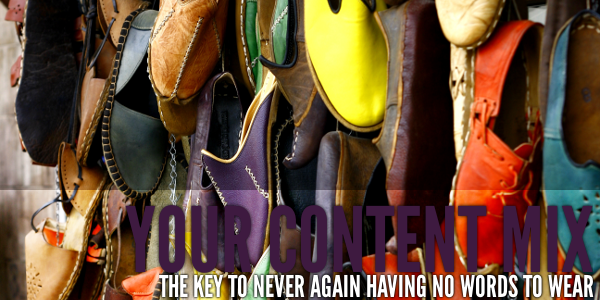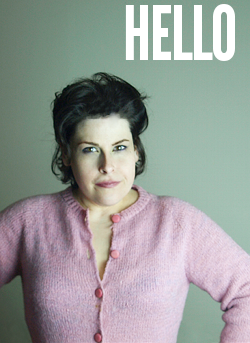Your Content Mix
By Jessica Albon

Shoes by Ömer Ünlü
Have you ever stood in front of your closet with absolutely no idea what to wear?(Please tell me it’s not just me!) Usually, this isn’t because our options are naked or PJs, but rather because nothing quite strikes our fancy or feels quite right.
Similarly, those days when you feel like you have nothing to write or talk about, when you feel stuck on what kind of content you should be creating, it’s unlikely that you’re actually completely out of ideas. Rather, it’s that none of your ideas feel quite right. You might not know where to start or what to do next, you might be feeling like you’re not getting the results you want and so you’re struggling to say something spectacular enough to get you noticed, or you might just plain be bored with your content and want to throw it all out and start fresh.
Whether or not you can relate to feeling like you have nothing to wear, I’m betting you can definitely relate to that “nothing to write” feeling. So today, let’s explore how you can prevent it.
See, just like having something to wear is about having a balanced wardrobe–one where you have clothes for the different activities and audiences of your life–having something to write about (or talk about, for those of you who mostly do multimedia content) is about having a balanced content mix.
Just like most people need dress shoes and sneakers, when it comes to content, most of us need:
- Beginner topics
- Advanced topics
- Real life examples (like case studies or before and after photos)
- Larger than life examples (profiling a great in your industry who accomplished something extraordinary, for instance)
- Graphic content (like infographics, photos, and charts, etc)
- Text-heavy content
- Research-heavy content
- Experience-heavy content
- Actionable content
- Inspirational content
- Bossy/motivational content
- Goal-oriented content (the stuff that helps you reach your goals–i.e. a sales pitch, if you want your newsletter to make sales)
- Long term content
- Short term content (the stuff that you won’t be talking about six months from now)
- Substance-rich content
- Pillar content (the fundamentals of what you do)
- Answers to popular questions
- Answers to unpopular questions
- Lecture-style content
- Discussion-style content
- And that’s just scratching the surface!
I’ve found that most of my clients have pretty good instincts about this. Once they know the wide range of content types available to them, they get a pretty good sense of what they need more of and what they’ve been over relying on, just like you probably know what’s missing from your wardrobe and what you tend to reach for more than anything else.
So, today, take a few minutes to look at your approach to content. What types of content do you tend to reach for too often? Which types are you missing?
Working to balance out your content mix will make it easier to stay interested in creating your own content and it’ll keep your audience interested as well.
Of course, having a carefully constructed plan is a great way to make sure that your content stays balanced over time (and I’m happy to help you create exactly that) but don’t underestimate the usefulness of doing this informally on your own. It might not be perfect, but it will make a difference.
Creating your own content mix means less time staring at a blinking computer cursor thinking you have no words to wear!
Blog





